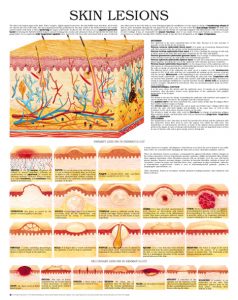Skin Lesions
The skin is the largest organ of the body. With a complex, highly organized structure, the skin fulfills many functions, all of which are vital for the rest of the body. The most important function performed by the skin, which is the border between the outside and the inside of the body, is that of protecting the organs underneath. To play its role, the skin acts as an imperfect protective barrier by keeping the hydroelectrolytic balance and preventing germs, toxins and substances that are harmful for the body from going inside; it is an important body temperature regulator since it preserves the heat with vasoconstriction in case of cold and
also allows heat to leave the body as sweat through peripheral vasodilation; it is the organ in charge of transforming vitamin D into its active metabolite through the role played by the sun´s rays; it is one of the first immunologic barriers the body uses against alien organisms since both the epidermis and the dermis are naturally equipped with inflammatory cells; the thousands
of nerve endings it has are responsible for sensory functions; since it can easily reveal such features as shyness, or such occurrences as a fright by turning either reddish or pale, it has also been designated as the organ of expression.
[hfe_template id=’14716′]
[hfe_template id=’16373′]

